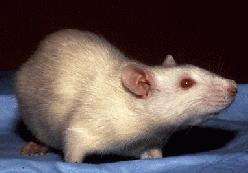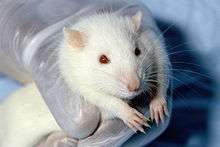Open field (animal test)
Developed by Calvin S. Hall, the open field test is an experimental test used to assay general locomotor activity levels, anxiety, and willingness to explore in animals (usually rodents) in scientific research.[1][2][3][4] However, the extent to which behavior in the open field measures anxiety is controversial.[5]
Concept
Animals such as rats and mice display a natural aversion to brightly lit open areas. However, they also have a drive to explore a perceived threatening stimulus. Decreased levels of anxiety lead to increased exploratory behavior. Increased anxiety will result in less locomotion and a preference to stay close to the walls of the field (thigmotaxis).[6][4]
Experimental design

The open field is an arena with walls to prevent escape. Commonly, the field is marked with a grid and square crossings. The center of the field is marked with a different color to differentiate from the other squares. In the modern open field apparatus, infrared beams or video cameras with associated software can be used to automate the assessment process.[7]

Behavioral patterns measured in the open field test include:[8]
- Line crossings – Frequency with which the rodent crosses grid lines with all four paws (a measure of locomotor activity), sometimes divided into activity near the wall and activity in the center
- Center square entries – Frequency with which the rodent enters the center square with all four paws
- Center square duration – Duration of time spent in the central square
- Rearing – Frequency with which the rodent stands on its hind legs in the field. Rearing-up behavior in which the forepaws of the animal are unsupported and the similar behavior in which the forepaws rest against the walls of the enclosure have different underlying genetic and neural mechanisms and unsupported rearing might be a more direct measure of anxiety.[9][10][4]
- Stretch attend postures – Frequency with which rodent demonstrated forward elongation of the head and shoulders followed by retraction to the original position. High frequency indicates high levels of anxiety.
- Defecation and urination – The frequency of defecation and urination is controversial. Some scientists argue that increase in defecation shows increased anxiety. Other scientists disagree and state that defecation and urination show signs of emotionality but cannot be assumed to be anxiety
Criticisms
The assumption that the test is based on conflict has been heavily criticized. Critics point out that when measuring anxiety each choice should have both positive and negative outcomes. This leads to more dependable observations which the OFT does not present.
When the test was first developed, it was pharmacologically validated through the use of benzodiazepines, a common anxiety medication. Newer drugs such as 5-HT-1A partial agonists and Selective serotonin reuptake inhibitors which have also been proven to treat anxiety show inconsistent results in this test.[6]
Due to the idiopathic nature of anxiety, animal models have flaws that cannot be controlled. Because of this it is better to do the open field test in conjuncture with other tests such as the elevated plus maze and light-dark box test.[11]
Different results can be obtained depending on the strain of the animal.[4] Different equipment and grid lines may cause different results.[12]
See also
- Animal models of depression
- Forced swim test
- Hole-board test
- Tail suspension test
References
- Denenberg, Victor H. (July 1969). "Open-field behavior in the rat: What does it mean?". Annals of the New York Academy of Sciences. 159 (Experimental Approaches to the Study of Emotional Behavior): 852–859. doi:10.1111/j.1749-6632.1969.tb12983.x. PMID 5260302.
- Hall, CS; Ballachey EL (1932). "A study of the rat's behavior in a field: a contribution to method in comparative psychology". University of California Publications in Psychology. 6: 1–12.
- Stanford, SC (2007). "The open field test: Reinventing the wheel". Journal of Psychopharmacology. 21 (2): 134–135. doi:10.1177/0269881107073199. PMID 17329288.
- Crusio, WE (2013). "The genetics of exploratory behavior". In Crusio, WE; Sluyter, Frans; Gerlai, RT; Pietropaolo, S (eds.). Behavioral Genetics of the Mouse. Cambridge, United Kingdom: Cambridge University Press. pp. 148–154. ISBN 978-1-107-03481-5.
- Sturman, O; Germain, P-L; Bohacek, J (2018-02-16). "Exploratory rearing: a context- and stress-sensitive behavior recorded in the open-field test". Stress. 21 (5): 443–452. doi:10.1080/10253890.2018.1438405. PMID 29451062.
- Ennaceur, A (2013). "Tests of unconditioned anxiety — Pitfalls and disappointments". Physiology & Behavior. 135: 55–71. doi:10.1016/j.physbeh.2014.05.032. PMID 24910138.
- Samson, Andre L.; Ju, Lining; Ah Kim, Hyun; Zhang, Shenpeng R.; Lee, Jessica A. A.; Sturgeon, Sharelle A.; Sobey, Christopher G.; Jackson, Shaun P.; Schoenwaelder, Simone M. (2015-01-01). "MouseMove: an open source program for semi-automated analysis of movement and cognitive testing in rodents". Scientific Reports. 5: 16171. doi:10.1038/srep16171. ISSN 2045-2322. PMC 4632026. PMID 26530459.
- Crusio, WE; Sluyter, Frans; Gerlai, RT (2013). "Ethogram of the mouse". In Crusio, WE; Sluyter, Frans; Gerlai, RT; Pietropaolo, S (eds.). Behavioral Genetics of the Mouse. Cambridge, United Kingdom: Cambridge University Press. pp. 17–22. ISBN 978-1-107-03481-5.
- Crusio WE (November 2001). "Genetic dissection of mouse exploratory behaviour". Behavioural Brain Research. 125 (1–2): 127–132. doi:10.1016/S0166-4328(01)00280-7. PMID 11682103.
- Sturman, O; Germain, P-L; Bohacek, J (2018-02-16). "Exploratory rearing: a context- and stress-sensitive behavior recorded in the open-field test". Stress. 21 (5): 443–452. doi:10.1080/10253890.2018.1438405. PMID 29451062.
- Ramos, A (2008). "Animal models of anxiety: do I need multiple tests?". Trends in Pharmacological Sciences. 29 (10): 493–498. doi:10.1016/j.tips.2008.07.005. PMID 18755516.
- Kulesskaya, Natalia; Voikar, Vootele (2014). "Assessment of mouse anxiety-like behavior in the light–dark box and open-field arena: Role of equipment and procedure". Physiology & Behavior. 133: 30–38. doi:10.1016/j.physbeh.2014.05.006. PMID 24832050.
